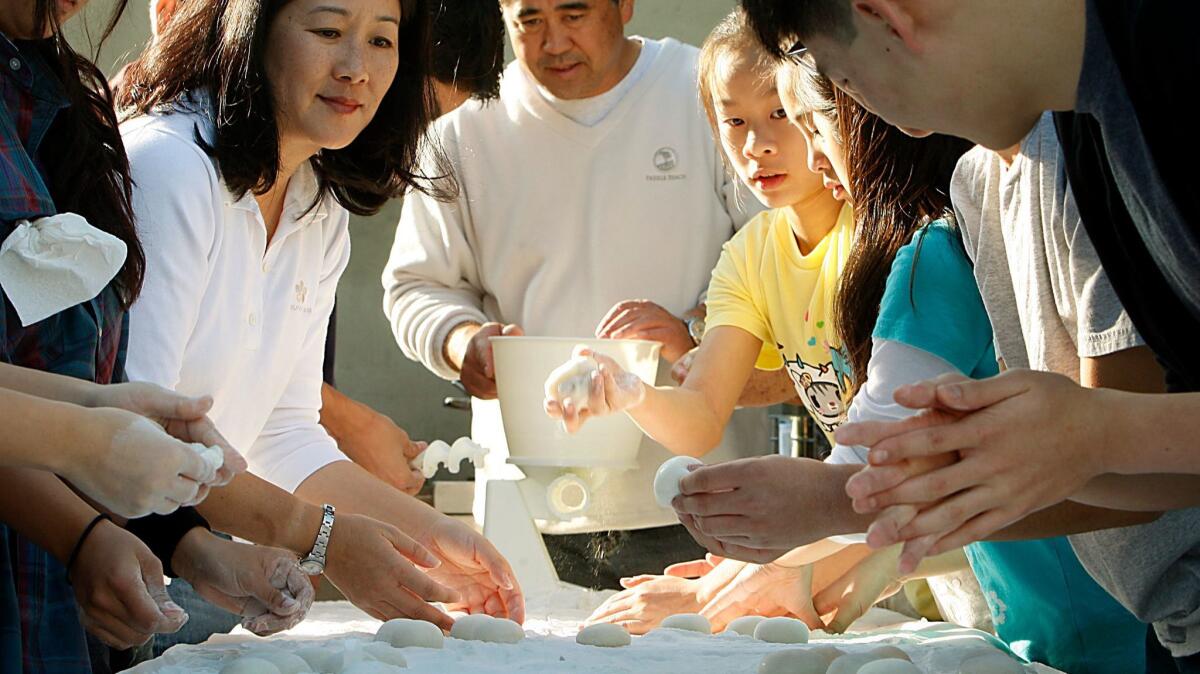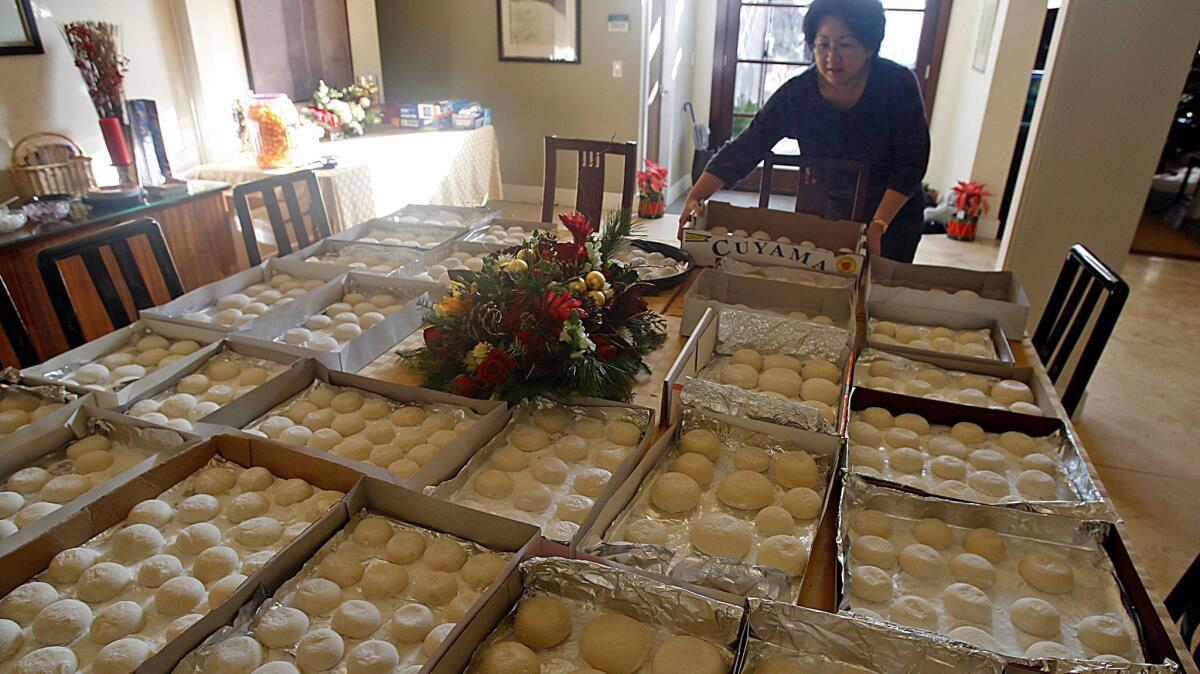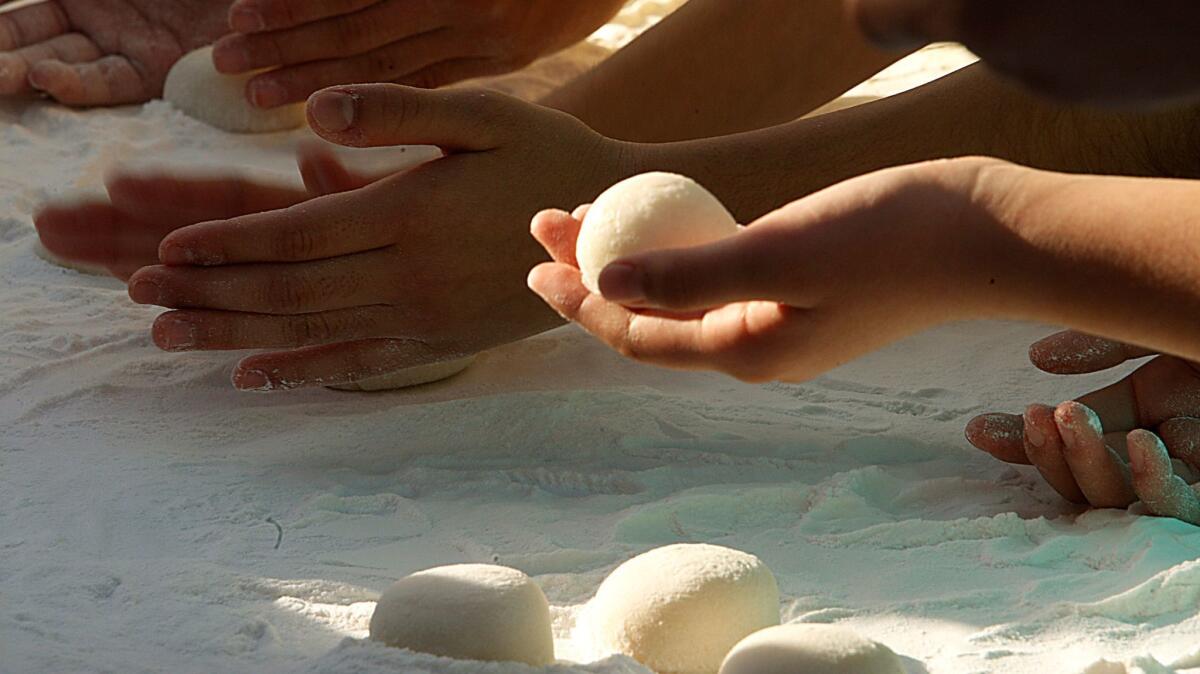Japanese American family keeps up mochi-making new year tradition

In a bright, modern home in a Monterey Park neighborhood, three generations of a Japanese American family made way for the new year with an ancient tradition.
A hundred pounds of glutinous rice had been soaking since the previous night. In the morning, the rice was drained, steamed and pounded into a soft, sticky mass. Then the Akiyoshi-Katayama family — three grandparents, four parents and six children, along with assorted friends — lined up at a long table for the final step in the process of making Japanese rice cakes known as mochi.
Two grandfathers cut the piping-hot dough into small pieces and tossed them on the table covered with white paper dusted with rice flour. Hands large and small reached for the pieces and shaped them into spheres, turning them lightly and quickly. The family members bantered as they worked, reminiscing about times past when Grandma taught them techniques she learned from her parents, who learned from their parents and on down through the ages.
Now, generations later on the final day of 2008, the most unusual aspect about the family ritual is that it happened at all.
“Most of my friends have no idea how to make mochi,” said Kenneth Akiyoshi, 16, a fifth-generation Japanese American whose parents, Cary and Tammie, have hosted the family mochi-making event for more than two decades. “Their parents don’t want to keep up the traditions, but I think they’re really important.”

For at least 13 centuries, the Japanese have made mochi. Once the hallowed food of emperors, it came to be used as offerings to the gods, a portable snack for traveling samurai and, eventually, as a de rigueur food for the masses during the Japanese New Year season. The rice cakes traditionally symbolized purity and strength.
The mochi is dropped in soup, stuffed with sweet bean paste, rolled in soybean flour, dipped in sugary soy sauce, grilled and wrapped in seaweed. It is also used as a New Year’s decoration — two rice cakes stacked on each other and topped with a tangerine representing the generations — as a symbol of good luck.
In Japan, mochi is still eaten during the New Year season by the vast majority of people — nearly 90% of respondents in a 2001 survey commissioned by a Japanese sake maker, Konishi Brewing Co. Ltd.
If somebody doesn’t keep it going, the tradition will die.
— Cary Akiyoshi
But in Southern California, both commercial and community mochi makers say demand for the seasonal rice cakes has dropped significantly.
In Little Tokyo, owners of century-old Japanese sweet shops say they don’t sell mochi nearly as much as they used to. Frances Hashimoto of Mikawaya said her New Year’s output has dropped to 3,000 pounds of rice from 6,000 pounds in the last few years. At Fugetsudo on 1st Street, owner Brian Kito said he expects to sell 10,000 pounds this year, down from his peak production of 16,000 pounds in the 1960s.
Community organizations, too, have noted a decline. The Orange County Buddhist Church, for instance, has decreased its output to 1,000 pounds this year from 1,800 pounds in the late 1960s.
Some blame low-carb diets for the decline, saying that fewer people want to stuff themselves with gobs of sticky white rice. Others say cultural assimilation is the reason, as successive generations stray from the traditions of ancestral Japan. The community bonds that kept mochi-making as much a social opportunity as a gastronomic one may have weakened as Japanese Americans have scattered to the suburbs.

“We’re seeing declining levels of mochi consumption, and it has to do with cultural assimilation and not maintaining traditions,” said Steve Matsubara, president of the Southeast Los Angeles North Orange County chapter of the Japanese American Citizens League, which has halved its production in the last decade.
But in the Akiyoshi home, the traditions remain strong.
Tammie Akiyoshi’s father, Ken Katayama, can recall mochi-making that dates back to 1930s Japan, where he spent five years as a young student. Back then, he said, families would pound the steamed rice in hollowed-out tree trunks with wooden mallets, then cut and shape the rice cakes by hand.
Nearly eight decades later, technology has changed the rituals and made it easier for individual families to make their own mochi. The Akiyoshi family uses multilevel aluminum steamers, an electronic pounding machine and a contraption equipped with a hand crank to push out the steaming dough and a blade to cut it into small pieces.
The pounding machine was purchased more than two decades ago by Cary Akiyoshi, a Monterey Park contractor who missed the mochi that his uncle sent every year until the latter shut down his Japanese pastry shop. After visiting a friend whose family made its own mochi, Akiyoshi decided to invest what seemed at the time an outrageous sum on the equipment — nearly $500 for the pounding machine and, later, an additional $1,000 for two multilevel steamers.
“Everyone thought we were nuts,” Akiyoshi said, “but it’s turned into a really fun tradition. We want our children to be proud of being American, but we also want them to know where they came from and be proud of being Japanese too.”
As he turned out a new batch of pounded rice ready for cutting and shaping, Akiyoshi called his family and friends to gather at the table. His daughter, 11-year-old Taryn, lined up with three friends from school and her community basketball team. The parents encourage their children to invite new friends each year to spread the tradition.
Taryn’s aunt, Karen Kawaguchi, showed the girls how to shape the rice gobs into soft round pillows with the edges of their hands just as grandma taught her. Too much flour and the top will crack. Too much handling and the mochi will get tough. The aim is a perfectly round sphere with a glistening sheen on top.
“Oh, they look pretty,” Kawaguchi said, surveying their smooth discs. “Like someone’s beautiful face.”
In between batches, the family played basketball, chatted, ate sushi and chili rice. Even for professionals like Kito of Fugetsudo, mochi-making — known in Japanese as mochitsuki — is still about bringing together family and friends. Year after year, old friends gather at his shop at 2 a.m. to help him get out his enormous holiday orders. His nieces help out at the counter; his brother-in-law comes in to help deliver the special orders.
“The whole idea of mochitsuki is bringing family together,” Kito said. “It’s about teamwork to get a mission done.”
The Akiyoshi children, Kenneth and Taryn, have no doubt that they will keep the tradition going. Kenneth, in fact, said he sees growing interest in mochi across the broader public.
Popular frozen yogurt shops, such as Pinkberry and Yogurtland, offer small mochi pieces as one of their toppings. This past Halloween, Kenneth said, one of his non-Japanese friends dressed up in a mochi costume. Mochi ice cream, invented by Hashimoto’s Mikawaya, is sold at such mainstream stores as Trader Joe’s.
If mochi eating goes mainstream, can mochi making be far behind?
“If somebody doesn’t keep it going, the tradition will die,” Cary Akiyoshi said. “So you hope by exposing your kids and friends to it, they’ll keep it strong.”
ALSO
Heavy snow forces 2-hour closure of the Grapevine; plows can’t keep up
2 killed, several injured in multiple-vehicle crash on Interstate 5 near Bakersfield
L.A. sheriff’s deputies disciplined after horrific torture death of 8-year-old boy
More to Read
Sign up for Essential California
The most important California stories and recommendations in your inbox every morning.
You may occasionally receive promotional content from the Los Angeles Times.











